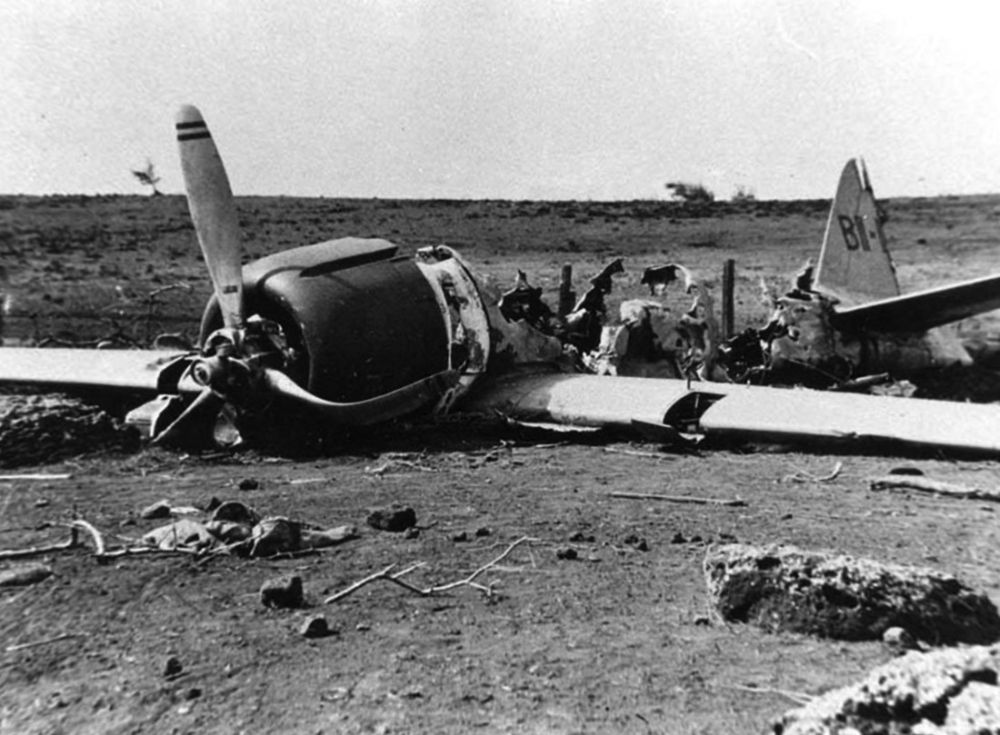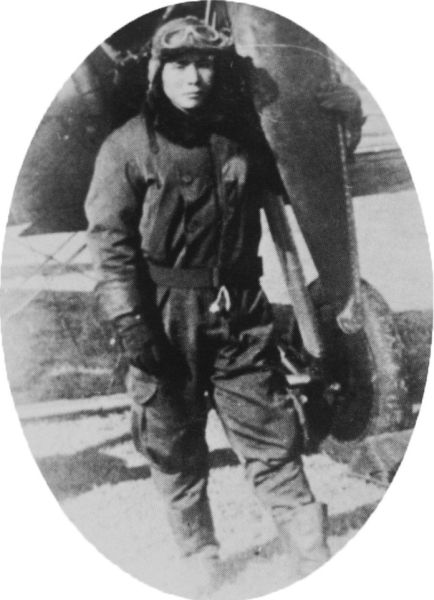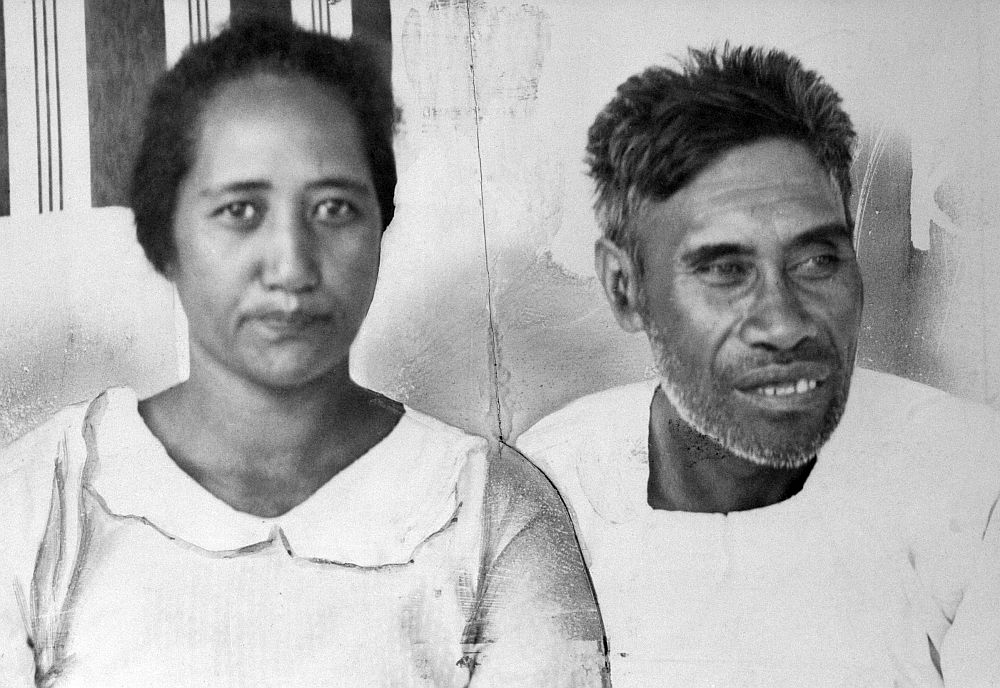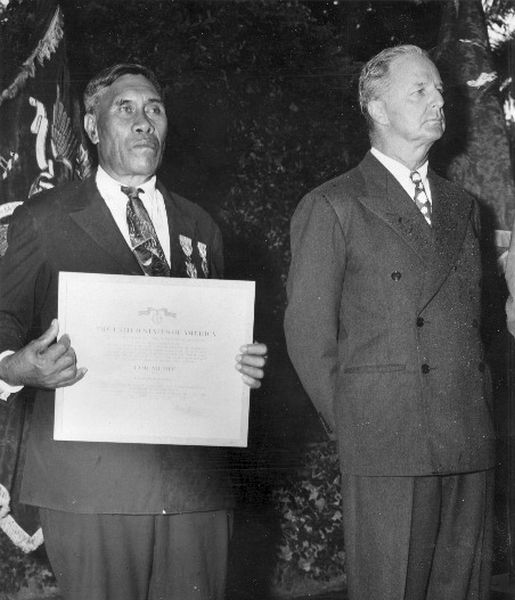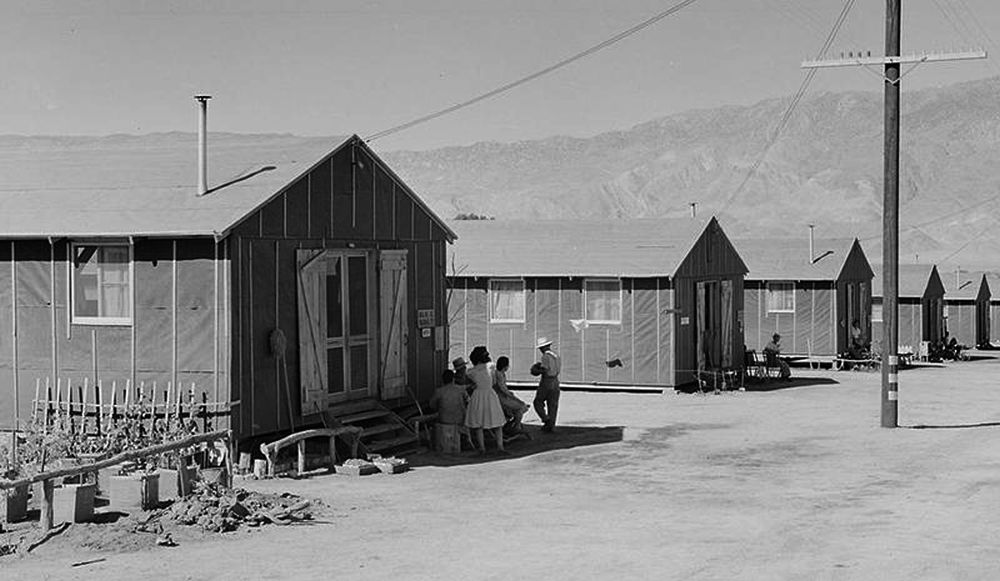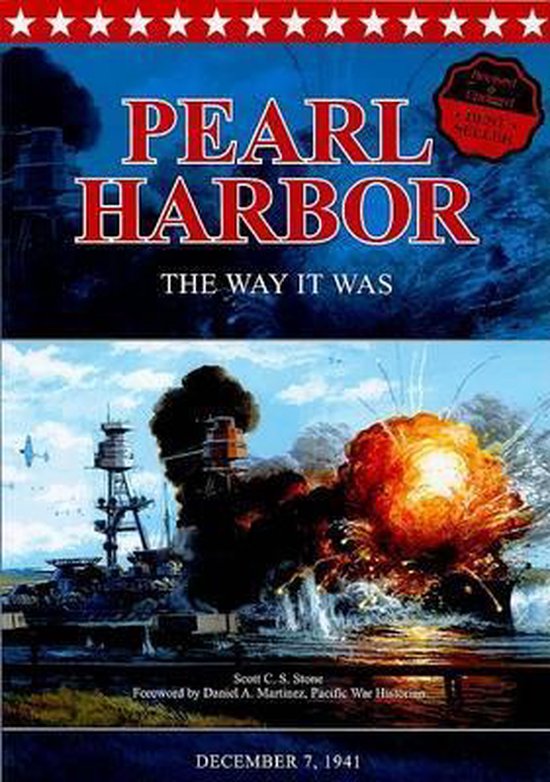Introduction
Sunday, December 7, 1941, will be remembered by most people as the day of the Japanese attack on Pearl Harbour. In two waves, 354 Nakajima B5N torpedo bombers, Aichi D3A dive bombers and Mitsubishi A6M Zero fighters, launched from six aircraft carriers, attacked the American Naval base on Ohau, Hawaii. Because at that time Japan had not yet declared war on the United States, the air raid came as a complete surprise. The declaration of war arrived a few hours after the attack. On the same day, the USA declared war on the land of the Rising Sun and the Americans became directly involved in the Second World War.
One of the 354 pilots who attacked Pearl Harbour was 22-year-old Sergeant 1st class Shigenori Nishikaichi. In his A6M2B Zero fighter with registration BII-120, he had taken off from the carrier Hiryu and participated in the second attack wave. Nishikaichi had attacked Bellows Field air field with his 20mm cannon and 7.7mm machineguns and destroyed American aircraft on the ground. He had seen how the battleship USS Arizona was bellowing thick clouds of black smoke after having been hit by a Japanese bomb that had exploded in the forward magazine at 8:10 am local time. The young Japanese pilot had seen other American vessels on fire, especially battleships. He had also seen how he and his fellow pilots had wreaked death and destruction among the crew members of the ships in Pearl Harbour and on the military airfields. But Nishikaichi had also seen that despite the surprise, American soldiers had managed to open fire at the Japanese aircraft, mainly with anti-aircraft guns from the warships. He had also gotten into a short fight against a few Curtiss P-36 Hawks, which had managed to take off in the chaos. However, Nishikaichi had managed to shake them off quickly.
During the Japanese attack on Pearl Harbour only 29 aircraft were lost, which were readily recognizable by the large red roundels underneath and on top of the wings and on the fuselage. Unfortunately for Shigenori Nishikaichi, he would become one of those. When the young pilot flew away from the crippled American naval base, he noticed that his Nakajima NK1C Sakae motor started to sputter. He looked over his shoulder and noted that smoke came from beneath his right wing. His fuel tank was leaking. Nishikaichi didn't know if this had been caused by anti-aircraft fire or the 12.7mm bullets from the Hawks. He realized that it would be impossible to return to his carrier. According to his latest instructions he was to divert to the Hawaiian island of Niihau, which the Japanese thought was uninhibited. There a submarine would be on standby to pick him and other pilots up. He passed the island of Kauai on his right and set course to Niihau, some 240 kilometers from Pearl Harbour.
Definitielijst
- battleship
- Heavily armoured warship with very heavy artillery.
- cannon
- Also known as gun. Often used to indicate different types of artillery.
- raid
- Fast military raid in enemy territory
- torpedo
- A weapon of war. A cigar shaped body fitted with explosives and a propulsion and control mechanism. Intended to target after launch a nearby enemy ship and disable it by underwater explosion.
Niihau
The small, westernmost Hawaiian island of Niihau measures only 181 square kilometers. It is approximately thirty kilometers long and a maximum of ten kilometers wide and can be compared in size to the Dutch island of Texel. The highest point of the island, Mount Paniau, is 381 meters above sea level. The island was bought in 1864 by Elizabeth Mchutchison Sinclair, descendant of a rich Scottish family from King Kamehameha V, together with parts of the neighbouring island of Kauai, for $ 10,000 in gold - a huge amount for that time. At that time, 350 indigenous Hawaiians lived on the island. The property rights went to the Robinson family, direct descendants of the Sinclairs. The Robinsons used a small part of the island for wool production but wanted to protect and preserve as much land and game as possible. The culture of the original population also had to remain unspoilt as much as possible. In 1915, Aubrey Robinson, a grandson of Elizabeth Sinclair, closed the island to visitors unless they were family of one of the residents and had a permit. This earned the island the nickname ‘forbidden island’. In 1939 Aubrey Robinson died and his son Aylmer succeeded him as owner and manager.
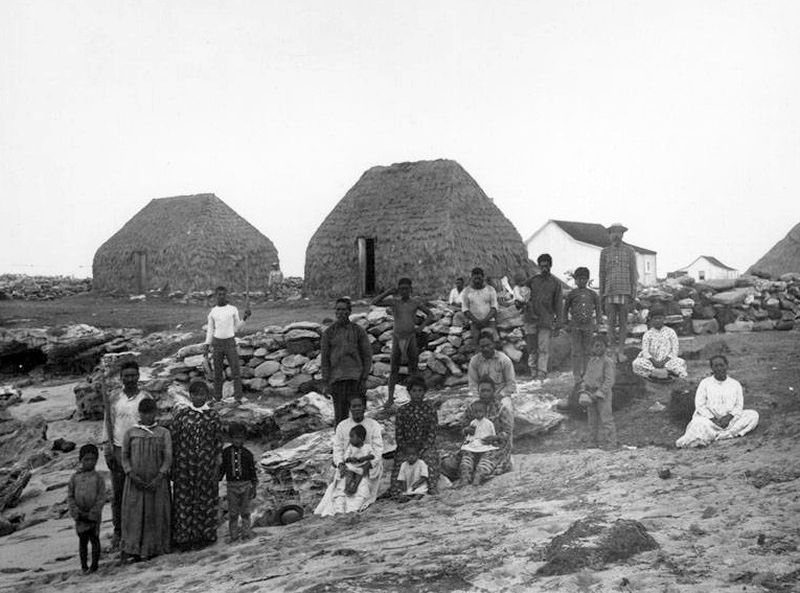
Inhabitants of Niihau 1885. The picture was taken by Francis Sinclair, the son of Elizabeth McHutchison Sinclair Source: public Domain
Aubrey and Aylmer Robinson had always cooperated with the American armed forces. With their permission, from 1924 on the US Navy was allowed to install an unmanned listening post and a forerunner to radar at Niihau. Just before the Second World War, the residents of Niihau ploughed the unused land with a tractor purchased by Aylmer Robinson to prevent enemy aircraft from landing. During the Second World War there was no direct contact between Niihau and the outside world. In an emergency, the islanders laid out a fire in the Eastern highlands to warn the authorities on Kauai. Sick or injured were transferred by rowing boat to the neighbouring island.
Nowadays Niihau is managed by owners and brothers Bruce and Keith Robinson, sons of Aylmer`s youngest brother Lester. The island has 170 residents officially, but most of them often stay on Kauai. To keep the island as original as possible, there still no telephones, paved roads or running water. Electricity has only recently installed in the form of solar energy. To protect the vulnerable island against diseases and bacteria, tourist visits are very restricted. A handful of chosen tourists can visit half a day by helicopter. The visitors are not allowed to disturb the residents in their activities and there is no hotel or restaurant. Stocks are supplied by boat from Kauai.
Definitielijst
- radar
- English abbreviation meaning: Radio Detection And Ranging. System to detect the presence, distance, speed and direction of an object, such as ships and airplanes, using electromagnetic waves.
Crash on Niihau
On Sunday, December 7 at 12:00, Shigenori Nishikaichi made an emergency landing on Niihau. He had assumed that the island was uninhabited, but in reality 136 people lived there at that time. The young Japanese pilot landed on a field that was ploughed deeply. His Zero bounced over the uneven soil and came to a halt with its nose in the ground, 70 meters away from the house of 29-year-old Hawaiian Hawila Kaleohano. The islander saw the plane come down and immediately rushed towards it. He jumped on the wing and found that the pilot was unconscious. Although Kaleohano knew nothing about the Japanese attack on Pearl Harbour, he recognized the aircraft as Japanese. Moreover, he was one of the few literates on the island and he knew that the relations between Japan and the United States had been very bad for a while already. That is why the islander first relieved the pilot of his semi-automatic 8mm Nambu pistol and took his papers before he helped the Japanese, who was regaining consciousness, get out of the wreck.

The Zero flown by Nishikaichi was readliy recognizable as Japanese due to the large red roundels Source: J-Aircraft
Kaleohano took the pilot to his house and provided him with food and coffee. He then sent a neighbour to assemble the residents of the island. Kaleohano had only lived on the island for eleven years and therefore had much more knowledge of the outside world than most of the islanders. Moreover, he was in close contact with the owner and manager Aylmer Robinson. He was therefore highly regarded, and his opinion was much respected. He convinced his neighbours that Nishikaichi might have ended up on the island because of the conflict between the United States and Japan. The owner-manager of the island, Aylmer Robinson, would visit Niihau on his weekly round the next day. The residents decided to place the Japanese pilot under guard until he could go to Kauai with Robinson. Because Nishikaichi spoke English so badly, Kaleohano appealed to the three islanders of Japanese descent. Since the 1880s, more than 150,000 Japanese worked on the Hawaiian plantations, three of them on Niihau.
The 60-year-old beekeeper of Japanese descent Ishimatsu Shintani was the first to interpret for Kaleohano. But after a short conversation with the young pilot, the beekeeper walked away without saying anything. Then Kaleohano called in the translation assistance of the 38-year-old Yoshio Harada. He was born on Hawaii and a had come to the island a few years ago after he received accounting work from Aylmer Robinson. His wife Irene was a born Japanese. After Harada had spoken with the pilot, he did not say anything either about the conversation. Harada did, however, convince the islanders to have them accommodate the Japanese pilot and guard him until Robinson arrived. However, the latter did not show up because a sailing ban had been announced after the attack on Pearl Harbour. Yoshida and Irene Harada were therefore stuck with the Japanese pilot.
Dangerous alliance
During the days of his semi-imprisonment, Nishikaichi managed to convince Harada that the Japanese would win the war quickly and that the accountant had to help him get his papers back. Those documents contained secret codes and instructions and the young pilot wanted to get them back at all cost. In the early afternoon of Friday December 12, Nishikaichi and Harada sent the beekeeper Shintani to Kaleohano to get the papers from him. The beekeeper even tried to bribe 29-year-old Hawaïan, but the latter did not budge and certainly did not hand over the documents. Shintani did not dare to face the Japanese pilot afterwards.
Nishikaichi and his Japanese American ally decided to take more drastic measures after the failed attempt by Shintani. First Harada sneaked to Aylmer Robinson's ranch to steal the only gun on the island. Irene Harada then distracted the guard at 4:30 pm, after which he was overpowered and locked up by the pilot. Then Nishikaichi and Harada went to Kaleohano by horse cart to claim the papers. Around 5:30 pm the Hawaïan, who was just in the separate toilet block, heard the armed couple arrive. Kaleohano wisely remained where he was while the pilot and his ally searched his house. They found no papers, but did find Nishikaichesi’s pistol.
The Japanese pilot and his Japanese American helper went to the wreck of the plane to see if the radio was still working, but they didn't get the device to work. They did, however, succeed in dismantling the two 7.7mm machine guns and loaded them onto the cart together with ammo for them. Then they set fire to the wrecked plane so as not to let it fall into American hands. At that time the two men saw Kaleohano flee, but despite a warning shot, the Hawaiian ran towards the village. There he warned as many residents as possible, and most of them fled to the highland. On horseback, Kaleohano then went to Mount Paniau as quickly as possible to ignite a warning fire that burned at 9 p.m. After brief consultations with the islanders, Kaleohano decided that the lighting of the fire was not enough. He quickly asked for a few volunteers and Kaleohano and six helpers sneaked to the only lifeboat of the island to row to Kauai, a trip of about ten hours. The trip from Kii Beach started half an hour after midnight.
War on Niihau
Shigenori Nishikaichi was furious and started driving himself and Yoshio Harada to despair. Together they rode the cart to the village to find Kaleohano. While shooting with a 7.7 mm machine gun and kicking in doors, they went from house to house. But they soon discovered that the village was abandoned. Suddenly the two frustrated men bumped into Kaahakila Kalimahuluhulu, who had brought his family to safety, but had returned to his house. The family man was held hostage and forced to call out names of others. However, the islanders did not respond and did not emerge from their hiding places. Nishikaichi and Harada let Kalimahuluhulu go again and went back to Kaleohano's house. They set fire to it in the hope of destroying the hidden papers. After his release, Kalimahuluhuluu looked for his neighbor Benhakaka, (Ben), Kanahele and together they stole one of the 7.7mm machine guns and ammunition from the cart of Nishikaichi and Harada. They buried the weapon and the bullets on the beach.
The next morning, Saturday, December 13, the Japanese pilot and his ally went back to the village to find islanders who could know something about Hawila Kaleohano who had apparently disappeared. At 10:00 a.m. they came across Ben Kanahele who was now accompanied by his wife Kealoha, (Ella). The Hawaiian, 2 meters tall and his wife had been hiding in a cave after Ben's nightly adventure but had returned to their house in search of food. The couple was held hostage and Ben was sent out to look for Kaleohano while his wife was threatened with death. The big Hawaiian then pretended for a while he was looking for him, but soon returned to the armed men and his wife with the message that he could not find his fellow islander. The small Japanese pilot started cursing the tall Hawaïan.
Ben Kanahele got tired of it and decided to intervene: "Take his gun before he kills someone," he told Harada in Hawaiian. "If I try, he will shoot me too," Harada replied dispiritedly. Yet the Japanese-American grabbed a few cartridges as if he wanted to reload the rifle that Nishikaichi was holding. The moment the pilot wanted to hand him the weapon, Ben Kanahele jumped onto Nishikaichi. But the pilot quickly dropped to the floor, grabbed the Nambu pistol from his boot and fired at Ben three times. The giant of Niihau was struck in the chest, hip and groin, but was not disabled. While Ella struck the gun out of the hands of the Japanese, Ben picked him up by his neck and legs and hurled him with great force against the wall of stacked stones.
The pilot struck his head against the stone wall and lost consciousness. Ben immediately went after Harada but could only watch how he pointed the barrel of the gun at his own belly and pulled the trigger. The tall Hawaiian immediately switched his attention to Nishikaichi and he saw how his wife shattered his skull with a stone. Ben pulled out his hunting knife and cut the throat of the Japanese. "I was furious!" Ben Kanahele testified later. He also praised his brave wife: "She did a good job crushing the skull of the Japanese".
Only on Sunday, December 14, help arrived on the island in the form of Aylmer Robinson, a priest and four soldiers from Company M, 299th Infantry from Kauai. The owner-manager of the island, Reverend Paul Larimore Denise, the soldiers, Hawila Kaleohano and the six rowers had to walk six hours from their landing site to the village. By the time they arrived there, Ella Kanahele was already on his way to them. She had dumped the pistol and the rifle of Robinson along the way. Arriving in the village, it turned out that the residents had already buried Shigenori Nishikaichi.
Definitielijst
- Infantry
- Foot soldiers of a given army.
- machine gun
- Machine gun, an automatic heavy quick firearm.
Epilogue
Ishimatsu Shintani was stuck on Kauai for a while, but soon returned to his family at Niihau. In 1960 he became nationalized and was allowed to call himself an American citizen. Irene Harada was locked up for 31 months in a prison camp in Honolulu on Ohau and was released in June 1944. She never had to stand trial for betrayal or any other crime and insisted to be innocent for a long time. Only in an interview with Japanese television in 1992 did she let go that she had helped Nishikaichi because she felt sorry for him. She never returned to Niihau and continued to live on the neighbouring island. Ben Kanahele recovered from his gunshot wounds in the Wainea Hospital on Kauai and after the war received a Medal for Merit, the highest civil decoration, and a Purple Heart, a tribute for wounded soldiers. Despite her courageous behavior, Ella Kanahele did not receive any official recognition. Hawila Kaleohano was awareded the Medal of Freedom and received $ 800 to rebuild his house.
The soldiers of Company M returned to the Coast Guard USS Kukui (a buoy laying vessel ) on December 17, which had dropped them off three days earlier at Niihau. They had the seized 7.7mm type 97 machine gun of the Zero, which was found on the beach, and the waterproof pouch with papers and maps of Nishikaichi with them. The second 7.7mm machine gun and the gun of the Japanese pilot have never been recovered. The gun of Aylmer Robinson was found by islanders in 1946 after a flood washed it up against a stone wall.
Definitielijst
- machine gun
- Machine gun, an automatic heavy quick firearm.
- Purple Heart
- American military award. Awarded to those who got wounded during war.
Deportation of Japanese-Americans
The Americans were shocked after the Japanese attack on Pearl Harbour and soon the Japanese-Americans were confronted with racism. The Niihau Incident certainly didn't do this any good. Many Americans wondered how it could have happened that the three inhabitants of Niihau of Japanese descent had defected to the the enemy so quickly. At the beginning of 1942, thousands of Japanese-Americans were deported and sent to so-called Relocation or Isolation Centers on the American mainland, because they were considered a threat to state security. Eventually some 120,000 Americans of Japanese descent were forced to sell their homes at ridiculously low prices and were locked up in fenced and guarded barracks without any form of luxury or privacy. Those who, according to the authorities, were an increased risk were even locked up in real prison camps. However, there has never been any evidence that the Niihau incident was the direct reason for this unlawful deprivation of liberty, such as angry tongues and some historians claim.
From the moment that the internment camps for the Japanese-Americans were a fact, there was criticism of the policy. It was a violation of the Constitution that those involved were locked up without any form of trial or intervention by a judge. Only on December 18, 1944, did the Supreme Court in Washington DC determine that citizens could not be interned without a trial. The Japanese-Americans were released in 1945. All they got was $ 25 and a train ticket home. But for many there was no home left and the victims of the drama demanded compensation and apologies from the US government. However, it took until 1976 before President Gerald Ford admitted that internment had been a "national mistake". After that it took another twelve years before President Ronald Reagan signed a law with which the former internees were entitled to compensation of $ 20,000.
Definitielijst
- racism
- Discrimination based on race.
Information
- Article by:
- Peter Kimenai
- Translated by:
- Francois Dumas
- Published on:
- 29-05-2022
- Last edit on:
- 30-09-2024
- Feedback?
- Send it!
